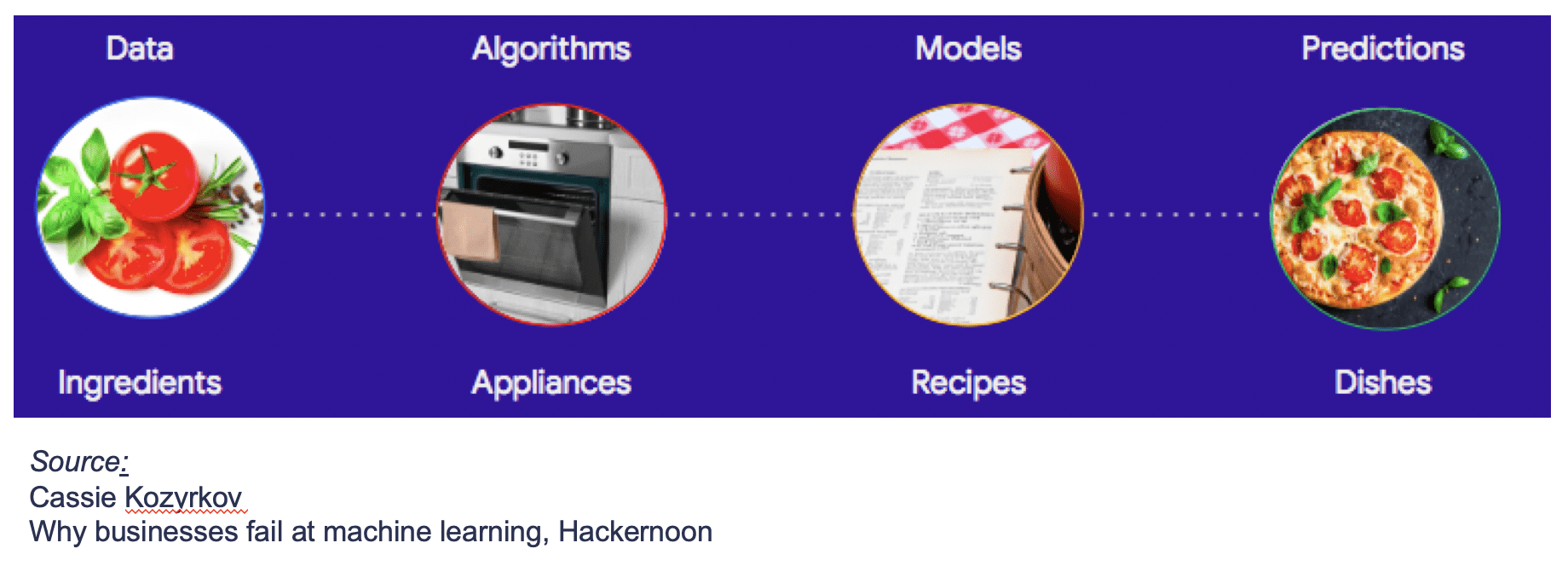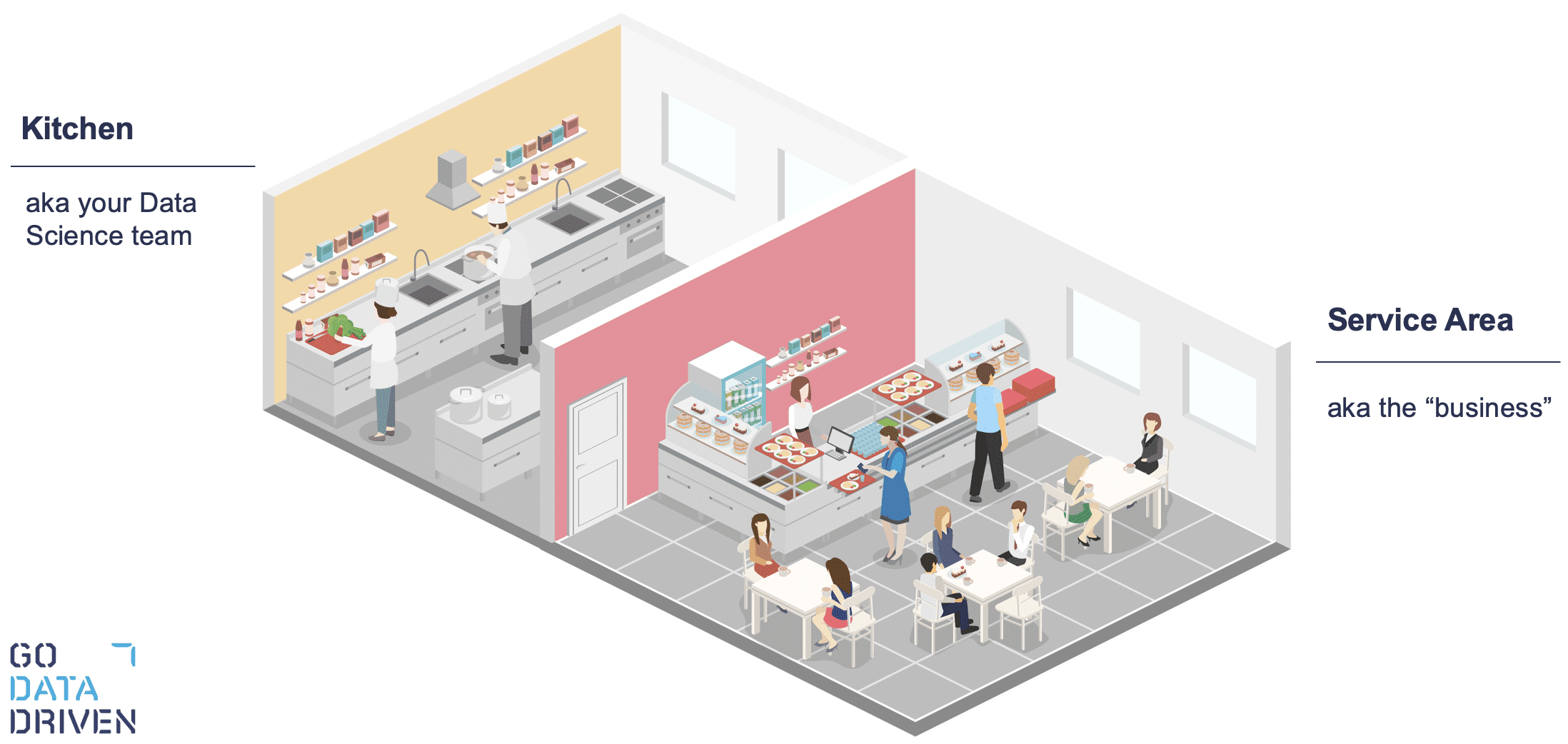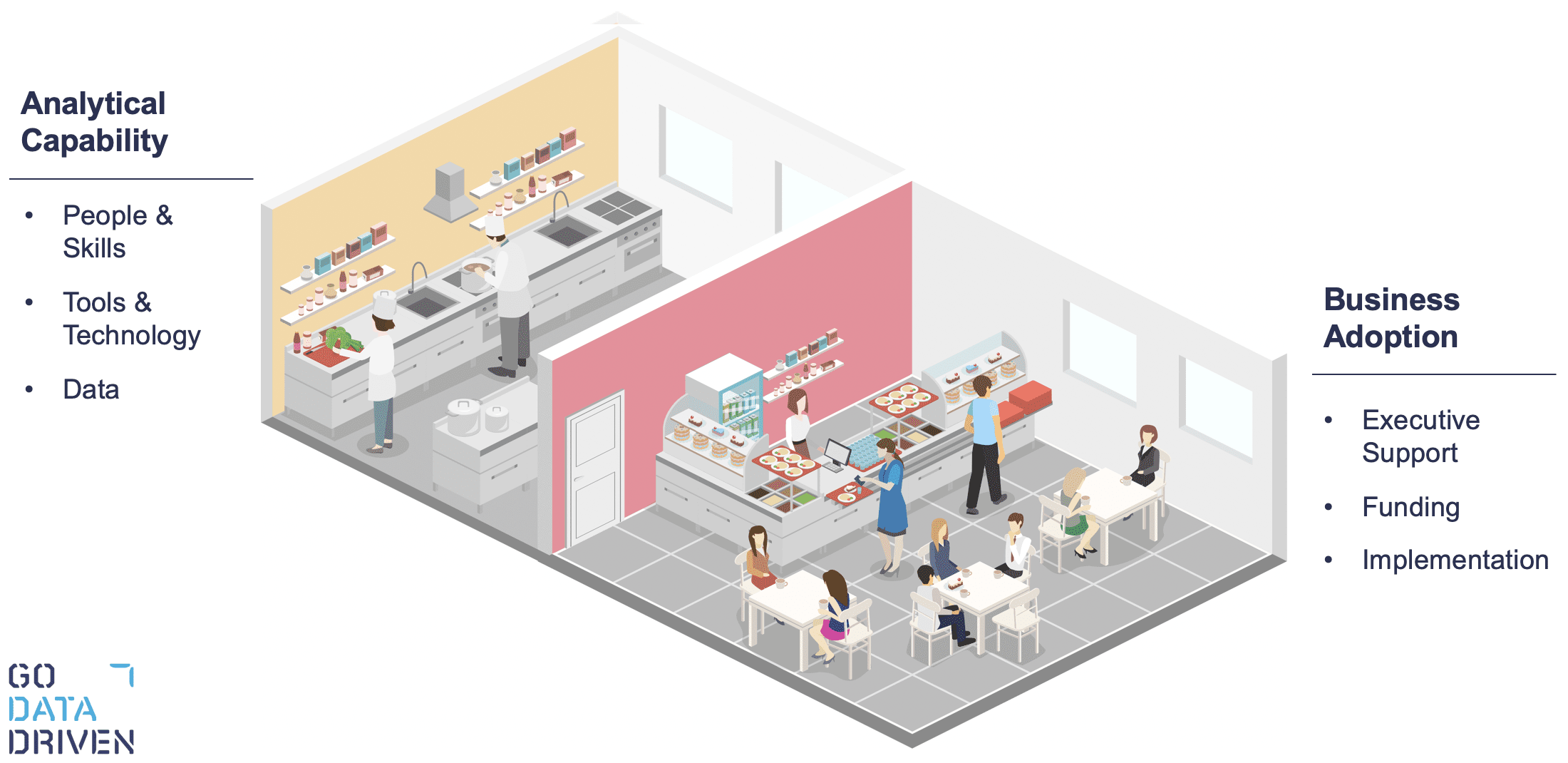
In our annual AI survey, we ask respondents if they have successfully developed AI applications that are adopted and used by the business. In 2019/2020 the answer was shockingly low: only 15% of the participating organisations did. This of course raises the question “How come we are so unsuccessful with AI?”.
This blog will answer that question by stating that success can only be achieved when both technical and business challenges are resolved. Using an analogy about a restaurant, we introduce 6 organizational success criteria to objectively score your AI practice. A follow-up blog post then uses this framework to show how you can level up your AI competency in a simple 3 step process.
The intended audience for this blog are Data Science Managers or Technical Team Leads who are looking for concrete tools to improve their practice.
You might feel that the analogy we are about to introduce oversimplifies things, and sure it does. However, we find from our consulting experience that such a simple analogy really helps to kick-start a discussion on what you are doing right and wrong organizationally. After all, a restaurant is something that everyone can relate to.
A pizza analogy
This blog builds on an existing pizza analogy about Data Science by Cassie Kozyrkov. In her post on Hackernoon, she argues that the main reason why businesses fail at Machine Learning is that they hire the wrong type of data scientists. She points out that many companies end up hiring machine learning researchers, instead of people who apply existing machine learning techniques to a business domain.
To make her point, she introduces an insightful pizza analogy to explain the different steps in data science from a technical perspective. In order to make a delicious pizza (i.e. valuable product), you need a recipe (model or formula) that tells you how to prepare your ingredients (data) using what appliances (algorithms). She then states that many companies have hired scientists who want to build new algorithms (appliances / ovens), instead of using existing algorithms to create new recipes for data products.

Figure 1: An analogy to explain data science made by Cassie Kozyrkov. It explains how different data science elements come together to achieve the final end result: predictions.
Now imagine this in a restaurant context: instead of hiring a chef who knows how to use an oven to make you great pizzas, you now have an electrical engineer who is going to invent a new oven… Can you see how this will not help your restaurant…?
Kozyrkov concludes that in order to run an industrial-scale kitchen you need an interdisciplinary team, including decision makers, domain experts and social scientists. These people will help a data scientist in doing the right thing, which is probably not inventing new algorithms (unless you are Google).
At GoDataDriven, we agree with this point. However, we see that even with such an interdisciplinary team, many businesses still fail at machine learning. In the next section of this blog, we would therefore like to thankfully expand her kitchen analogy to illustrate what some of the other failure modes are and how they can be measured and resolved.
The restaurant analogy
Successful data science is more than just ‘baking pizzas’. We have to deal with customers, employees and workfloor dynamics. Also, let’s not forget that the AI-pizzas that we are baking need to be sold in the end in order to run a profitable business. This focus on profitability is what makes the restaurant analogy a good representation of reality; something valuable has to come out.
So in order to better understand when AI products are successfully adopted and used by the business, we need to consider organizations as a whole.
Figure 2 depicts how organization are often organized:
- On one side, we have the kitchen (sticking to the pizza restaurant analogy) that is preparing the AI products. This is often it’s own (isolated) department sometimes called “Data Lab” or “Innovation Hub”. In the worst case, this team is tucked away within IT and it’s innovation never really reaches the rest of the organisation.
- On the other side, we have the service area where AI products should be used to generate value. This is where pizzas are sold and where the revenue is made. In practice, this side is often referred to as “the business” or the ”work floor” with its employees considered “operational staff”.

Figure 2: Employees in the Kitchen and Service Area of a restaurant need to work together in order to run a successful business. In practice however, we often see that these two sides of a business are quite isolated from each other.
Sadly enough, we often find that the separation is literally like this: business and data scientists working in different rooms with walls in between. In such a situation it’s easy to understand that there will be miscommunication. To name just a few of the issues we frequently see in these kind of situations:
- Whatever the cooks are preparing is not something your customers want (= lack of business need understanding).
- Your service employees don’t understand the new shiny dishes coming out of the kitchen and are reluctant to sell or embrace it (= lack of technology understanding).
- Your service employees might not even be aware of the fact that there is an AI team and what AI can actually do for them (= unawareness).
- Often, service employees are so busy doing their normal routine that they don’t have time to get to know the new AI menu (= no time for innovation).
- The restaurant manager doesn’t really have a vision on what type of AI dishes should be sold (= lack of vision and strategy).
All of the above lead to a disconnect between the kitchen (IT / Data Science) and the service area (Business / Operations). In real life, we often see more than one of the above things going wrong. And that white door that separates the Kitchen and Service Area in Figure 2 often remains firmly shut. In the most extreme cases, there isn’t even a door as IT and Business are literally located in different buildings. But on top of that all that, working remotely (due to COVID-19) makes it even harder to stay aligned.
To bridge the gap, we saw the introduction of a new role: the Analytics Translator. This role was coined in 2018, with the sole purpose of making sure both parties are in sync such that valuable AI products are delivered in the end. Luckily, these days more and more organizations reorganize in agile teams and position business and AI closely together.
How to do better?
To improve the situation, the first step is to know where you currently stand. In our free whitepaper on AI Maturity we define 3 success criteria for both the kitchen and service area that you can use to objectively quantify your organizational AI success.
From a technical perspective, we can evaluate your kitchen (i.e. your data science team) on the elements from the pizza analogy:
- People: Do you have good cooks who develop new recipes instead of new models?
- Tools: Do you have the right tools & appliances to facilitate the cooking?
- Data: How are your ingredients organized and used for valuable products?
As these three topics together are what you need to do analytics / data science, we rename this side of the organisation as your Analytical Capability.
On the other side, we need to quantify how the Business is dealing with AI innovation. We refer to this side as Business Adoption. From interviews with our top clients, we established three key metrics in the whitepaper as well:
- Executive Support: Successful organizations have C-level executives who provide a purpose which then leads to a business pull for use cases on the AI capability. AI use cases initiated by the business are almost always more successful than ideas pushed from a technology perspective.
- Funding: In successful organizations the business pays for AI solutions. There might be a small innovation budget to kick-start early exploration, but at some point there must be a hand-over. All initiatives are value tracked.
- Implementation. Successful organizations have a design process in place where the business is involved in kicking-off AI initiatives and testing them during development. The business is also responsible for roll out of AI products across the organisation.
A complete list with examples of mature and immature practices for the above metrics can be found in our free whitepaper.

Figure 3: Being successful with AI has both technical and business challenges to be resolved. From our experience and research we established 3 success criteria along each dimension to objectively measure your organization’s AI competency.
The point here is that you can use the analogy’s metrics along the two dimensions to objectively determine what is going well, and what can be improved in your organization across the board. Not just from a technical perspective, but also considering the business part.
With this framework in mind, leveling up your AI competency is a repetitive 3 step process. We encourage you to do a self assessment and start improving the way you are doing Data Science today. Alternatively, you could ask us to do a quick 3-week AI Maturity Scan for you.
Hopefully then, in a future edition of the Analytics Survey, we hope to see more than 15% of companies having successfully implemented AI products that are used and adopted by the business.




